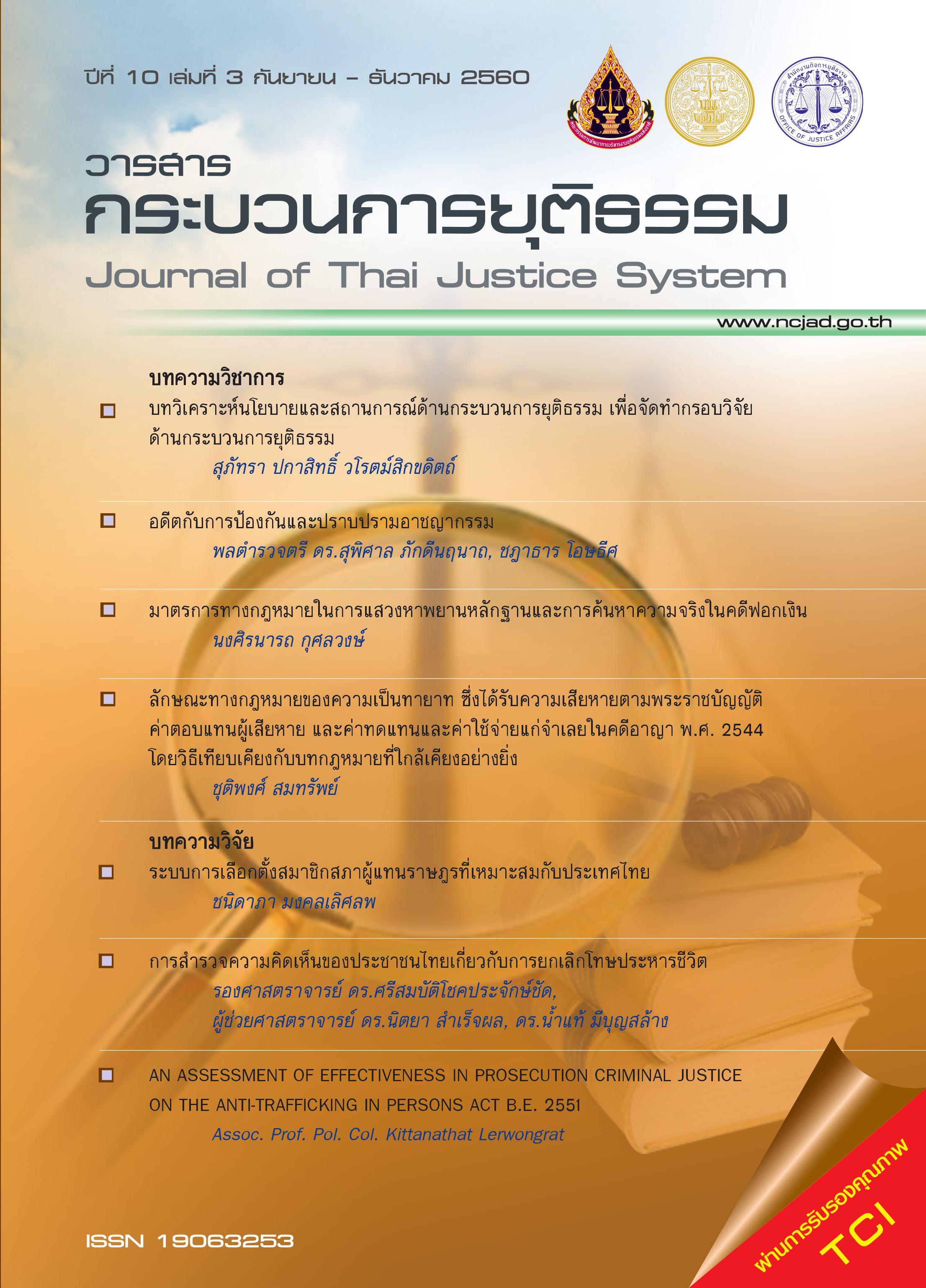ระบบการเลือกตั้งสมาชิกสภาผู้แทนราษฎรที่เหมาะสมกับประเทศไทย
Main Article Content
บทคัดย่อ
บทความนี้มีวัตถุประสงค์เพื่อศึกษาข้อความคิดว่าด้วยหลักประชาธิปไตยและระบบการเลือกตั้ง ศึกษาพัฒนาการและสภาพปัญหาระบบการเลือกตั้งในประเทศไทย เพื่อเสนอแนะระบบการเลือกตั้ง
ที่เหมาะสมสอดคล้องกับสภาพสังคมไทย ผลการศึกษาพบว่าระบบการเลือกตั้งของประเทศไทย ทั้งระบบการเลือกตั้งแบบเสียงข้างมากธรรมดา และระบบการเลือกตั้งผสมแบบคู่ขนาน ทำให้ผลการเลือกตั้ง
ไม่สามารถสะท้อนเจตนารมณ์ของประชาชนเจ้าของอำนาจได้อย่างแท้จริง ทั้งยังเป็นระบบที่มีแนวโน้ม
ทำให้พรรคการเมืองขนาดใหญ่ได้เปรียบ พรรคการเมืองขนาดกลางและพรรคการเมืองขนาดเล็กเสียเปรียบ ไม่เปิดโอกาสให้พรรคการเมืองที่จัดตั้งขึ้นใหม่สามารถพัฒนาตนเองในทางการเมืองได้ ขัดต่อวัตถุประสงค์ของการเลือกตั้งที่ต้องการให้ประชาชนเป็นผู้กำหนดอนาคตของประเทศโดยการเลือกผู้แทนของตนผ่าน
การเลือกตั้ง ทั้งนี้ แตกต่างจากระบบการเลือกตั้งแบบสัดส่วนผสมซึ่งเป็นระบบที่ใช้ในประเทศเยอรมนีและประเทศนิวซีแลนด์ โดยเป็นระบบที่มีหลักการคิดคะแนนซึ่งผลลัพธ์ของการเลือกตั้งแบบแบ่งเขตและ
การเลือกตั้งแบบบัญชีรายชื่อมีความเชื่อมโยงต่อกัน มีการชดเชยคะแนนเสียง อันเป็นผลให้ผลการเลือกตั้งสามารถสะท้อนเจตนารมณ์ของประชาชนได้อย่างแท้จริง คะแนนเสียงของผู้ออกเสียงได้สัดส่วนกับจำนวนที่นั่งที่แต่ละพรรคการเมืองได้รับตามความเป็นจริง ก่อให้เกิดความยุติธรรมแก่ทุกพรรคการเมือง ส่งผลให้ระบบพรรคการเมืองให้มีความหลากหลาย เป็นสถาบันที่มีอุดมการณ์และรากฐานจากประชาชน ดังนั้น ผู้เขียนจึงเห็นว่า ควรนำระบบการเลือกตั้งแบบสัดส่วนผสมมาปรับใช้ในประเทศไทย โดยเป็นการผสมระหว่างระบบการเลือกตั้งแบบเสียงข้างมากธรรมดาแบบเขตเดียวคนเดียว กับระบบสัดส่วนแบบบัญชีรายชื่อโดยแบ่งประเทศออกเป็นเขตเลือกตั้งตามเขตการปกครองที่ชัดเจนแน่นอน แต่ละเขตไม่จำเป็นต้องมีจำนวนประชากรเท่ากัน แต่ต้องให้ความเสมอภาคในการเป็นตัวแทนตามสัดส่วนประชากร และควรกำหนดอัตราส่วนระหว่างสมาชิกแบบแบ่งเขตกับสมาชิกประเภทบัญชีรายชื่อให้มีจำนวนเท่ากัน อีกทั้งรัฐควรเตรียมความพร้อมในด้านต่าง ๆ โดยเฉพาะอย่างยิ่งในส่วนของกฎหมายพรรคการเมืองด้วยการบัญญัติกฎหมายให้เป็นรูปธรรมเพื่อสร้างความเป็นธรรมให้เกิดขึ้นจริงกับพรรคการเมือง
Article Details
ต้นฉบับที่ได้รับการตีพิมพ์ในวารสาร เป็นลิขสิทธิ์ของวารสารกระบวนการยุติธรรม แต่ความคิดเห็นที่ปรากฏในเนื้อหาของบทความในวารสารกระบวนการยุติธรรม ถือเป็นความรับผิดชอบของผู้เขียนแต่เพียงผู้เดียว
เอกสารอ้างอิง
ชนิดา จิตตรุทธะ. รายงานวิจัยฉบับสมบูรณ์ โครงการวิจัย วัฒนธรรมทางสังคมของไทยกับการทำให้เป็นประชาธิปไตย. รายการการวิจัย ภาควิชารัฐศาสนศาสตร์ คณะรัฐศาสตร์ จุฬาลงกรณ์มหาวิทยาลัย, 2554.
ธานินทร์ กรัยวิเชียร. ระบอบประชาธิปไตย. พิมพ์ครั้งที่ 3. กรุงเทพฯ: โรงพิมพ์กรมแผนที่ทหาร, 2518.
นนท์วินิจ เจริญนวชัย. กฎหมายเลือกตั้ง. นครปฐม: ภูมิการพิมพ์, 2555.
นรนิติ เศรษฐบุตร. การเมืองการปกครองในระบอบประชาธิปไตยของไทย. พิมพ์ครั้งที่ 3. กรุงเทพฯ: สถาบันพระปกเกล้า, 2555.
นันทวัฒน์ บรมานันท์ และคณะ. “ยุทธศาสตร์การฟื้นฟูประเทศ เพื่อสร้างความเข้มแข็งของสังคมไทย” ยุทธศาสตร์ที่ 2 การปรับระบบบริหารภาครัฐและความสัมพันธ์ใหม่ในสังคม เรื่อง การปรับโครงสร้างของระบบรัฐสภา. กรุงเทพฯ: ธรรมดาเพรส, 2554.
บวรศักดิ์ อุวรรณโณ. เจตนารมณ์รัฐธรรมนูญ (4 ปี รัฐธรรมนูญ: ปัญหาและอุปสรรคต่อการปฏิรูปการเมือง). กรุเทพฯ: สถาบันพระปกเกล้า, 2544.
บุญศรี มีวงศ์อุโฆษ. แนวทางการปฏิรูประบบการเลือกตั้งและพรรคการเมือง. กรุงเทพฯ: สถาบันพระปกเกล้า, 2555.
พระราชบัญญัติประกอบรัฐธรรมนูญว่าด้วยพรรคการเมือง พ.ศ.2541
เรย์โนลด์ส, แอนดรูว์ และคณะ. การออกแบบระบบเลือกตั้ง: คู่มือเล่มใหม่ของ International IDEA. นครปฐม: สถาบันสิทธิมนุษยชนและสันติศึกษา มหาวิทยาลัยมหิดล, 2555.
วัชรา ไชยสาร. ระบบการเลือกตั้งกับการเมืองไทยยุคใหม่. พิมพ์ครั้งที่ 2. กรุงเทพฯ: นิติธรรม, 2544.
สนิท จรอนันต์. รัฐบาลทำงานอย่างไร. กรุงเทพฯ: พี. เพรส, 2545.
หยุด แสงอุทัย. หลักรัฐธรรมนูญและกฎหมายเลือกตั้งทั่วไป. พระนคร: โรงพิมพ์มหาวิทยาลัย ธรรมศาสตร์, 2513.
อุกฤษ มงคลนาวิน. บันทึกการเลือกตั้งผู้แทนตามอัตราส่วน. กรุงเทพฯ: ม.ป.พ., 2530.
เอกบุญ วงศ์สวัสดิ์กุล, อุดม รัฐอมฤต และกิตติพงศ์ กมลธรรมวงศ์. รายงานการวิจัยการศึกษาพัฒนาการของหลักกฎหมายเลือกตั้งของประเทศไทยและต่างประเทศ. รายงานการวิจัยเสนอต่อ สถาบันวิจัยและให้คำปรึกษาแห่งมหาวิทยาลัยธรรมศาสตร์, 2551.


